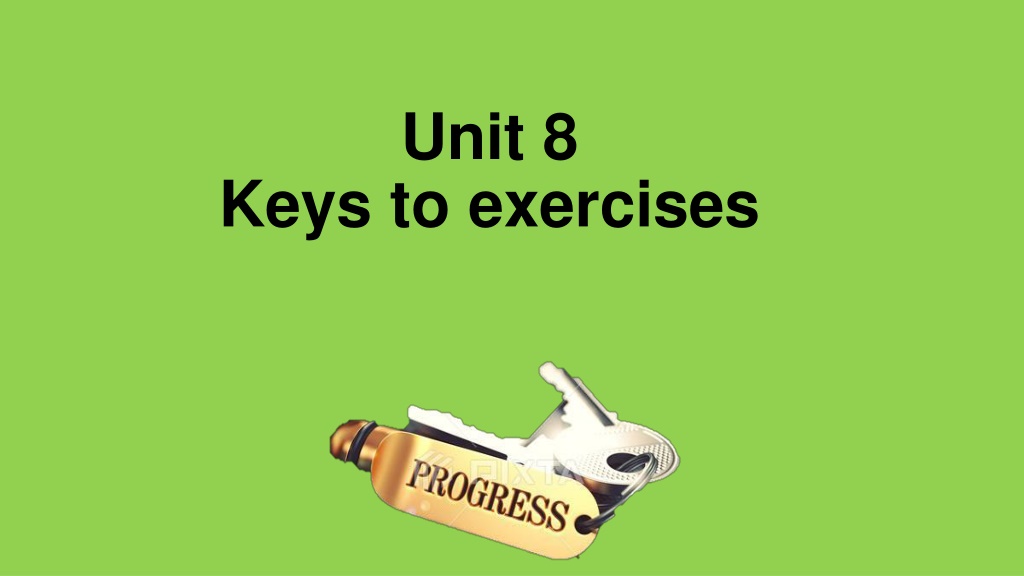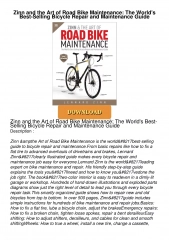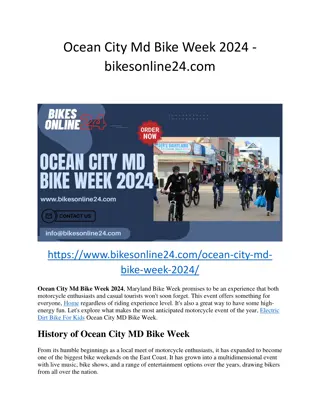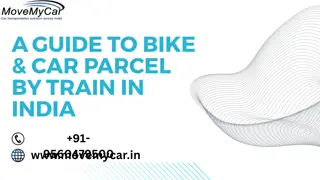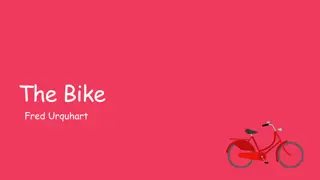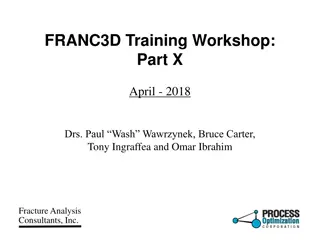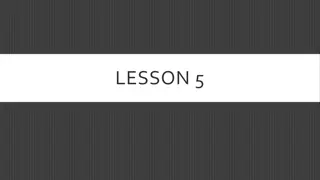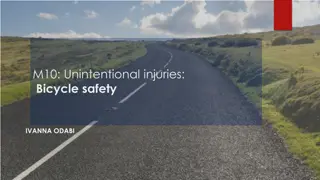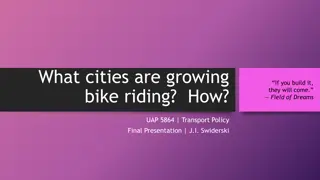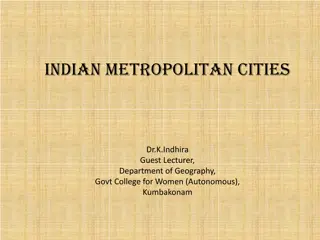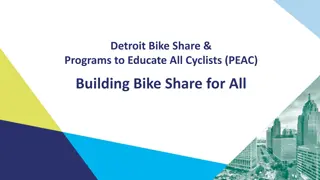Chinese Cities Crack Down on Bike-Sharing Services
Chinese cities are clamping down on bike-sharing services due to the overwhelming presence of bicycles on the streets. Authorities in cities like Shanghai, Nanjing, Guangzhou, and Zhengzhou are taking measures to control the number of bikes and regulate the industry. These actions include demanding companies to cease adding new bikes, relocating existing bikes, obtaining government licenses, and implementing rules for riders. This crackdown comes amid concerns about the chaotic situation caused by the excessive bikes, with the government stepping in to address the issue.
Download Presentation

Please find below an Image/Link to download the presentation.
The content on the website is provided AS IS for your information and personal use only. It may not be sold, licensed, or shared on other websites without obtaining consent from the author. Download presentation by click this link. If you encounter any issues during the download, it is possible that the publisher has removed the file from their server.
E N D
Presentation Transcript
Unit 8 Keys to exercises
Keys to exercises in Section A (Passage 1 P. 199) Reading Comprehension 1 Skimming & scanning 1 F 2 F 3 F 4 F 5 F 6 T
Keys to exercises in Section A (Passage 1 P. 200) Verbal Expression 1. Classification of automobiles.
Keys to exercises in Section A (Passage 1) Critical Thinking & Cultural Exploration 1 New Words and Expressions rubber and aluminum pedestrian edestrian [p 'destri n] n. adj. pile [pa l] n. v. pile up ; complex [k m'pleks] adj. n. office complexes municipal [mju 'n s pl] adj. bureau ['bj ro ] n. ( refrain [r 'fre n] v. n. resident ['rez d nt] n. adj. aggressively [ ' res vli] adv. scatter ['sk t r] v.
designated ['deznetd] adj. rack [r k] n. cease [si s] v. suspension [s 'spen n] n. pin [p n] n. v. halt [h lt] n. v. chaotic [ke ' t k] adj.
Keys to exercises in Section A (Passage 1 P. 201) Critical thinking and cultural exploration 1 Chinese cities are saying enough already to bike-sharing services For over a year, China s city streets have been flooded with bicycles. For a while, the mass of rubber ( ) and aluminum ([ lj m n m] ) blocked pedestrian walkways ( ) and piling up beside office complexes ([ k mpleks] ). But now, some cities are saying no more. On Aug. 18, 2017, Shanghai s municipal ([mju n s pl] ) transportation bureau sent a notice to a number of bike-sharing companies demanding they refrain from adding new bikes on the streets. According to the bureau, the city has 1.5 million sharing bikes on its streets about one for every 16 residents. The government also demanded that the companies aggressively relocate ([ ri l ke t] ) bikes parked and scattered carelessly across the city the services let customers return bikes anywhere, rather than only in designated ([ dez ne t d] ) racks. rubber and aluminum
Keys to exercises in Section A (Passage 1 P. 201) On Aug. 5, 2017, authorities in Nanjing demanded no new bikes hit the streets. They also called for companies to obtain government licenses for each of their bikes. On Aug. 3, 2017, authorities in Guangzhou also called for bike companies to cease putting new bikes on the streets, estimating that over 800,000 are in circulation ([ s kj le n] ). And on July 27, 2017, authorities in Zhengzhou demanded a similar suspension ([s spen n] ), pinning the number of bikes on the streets at 390,000. Halting the distribution of new bikes comes around the same time as China s Ministry of Transportation published the first country-wide framework for regulating the chaotic ([ke t k] ) industry. The rules stated that riders must register for services using their real names, that no company can offer rides to people under the age of 12, and that companies must provide insurance for riders.
Keys to exercises in Section A (Passage 1) Critical Thinking & Cultural Exploration 2 New Words and Expressions Hong Kong West Kowloon terminus ['t rm n s] n. inauguration [ n j 're n] n. depart [d 'p rt] vt. departure [d 'p rt r] n. formality [f r'm l ti] n. exit formalities valid ['v l d] adj. passport ['p sp rt] n. exit-entry permit
Keys to exercises in Section A (Passage 1 P. 201) Critical thinking and cultural exploration 2 Beijing Hong Kong high-speed train A new pair of high-speed trains has been launched between Beijing and Hong Kong on 23 September 2018. Operated with train numbers G79 and G80 between Beijing West and Hong Kong West Kowloon ( ) on a daily basis ( ), it is currently the fastest train service and the only high-speed train service between Beijing and Hong Kong, with an approximate travelling time of 9 hours. The Beijing Hong Kong high-speed train service dates back to 26 December 2012, when the Beijing Zhengzhou section of the Beijing Guangzhou Shenzhen Hong Kong high-speed rail was opened. At its opening, the service was between Beijing West and Guangzhou South under the numbers G79 and G82. Later on 28 December 2013, the southern terminus ([ t m n s] ) of the service was extended to Shenzhen North and the number of the Shenzhen-bound service was changed from G82 to G80. On 5 January 2017, the service was extended to Futian. With the inauguration of the Hong Kong section of the Guangzhou Shenzhen Hong Kong high-speed rail on 23 September 2018, the southern terminus of the service was extended to Hong Kong West Kowloon.
Keys to exercises in Section A (Passage 1 P. 201) For the passengers departing from Hong Kong, they are advised to get to Hong Kong West Kowloon Station 45 minutes in advance of the departure time for the exit formalities ([ eks t f m l tiz] ). The boarding gates close 10 minutes before departure from the station. Tickets can be bought either in Beijing or in Hong Kong by presenting valid passports, exit-entry permits ( ), or ID cards 60 days before departure. Passengers can also choose to buy tickets online from www.12306.cn.
Keys to exercises in Section A (Passage 2 P. 204) Reading Comprehension 1 Skimming & scanning 1 T 2 F 3 T 4 F 5 F
Keys to exercises in Section A (Passage 2 P. 204) Verbal expression 1 Parts of a car number plate / license plate headlight bonnet / hood windscreen / windshield aerial / antenna boot / trunk windscreen wiper / windshield wiper tyre / tire mirror wheel
Keys to exercises in Section A (Passage 2 P. 205) 2 Road signs 1st line: stop and give way give way stay left 3rd line: road narrow on the right side road narrow on both sides crossroads ahead and having priority ahead only towards the right 2nd line: no entry uneven road falling rocks turn left or turn right go ahead or turn right priority over oncoming vehicles dead end street
Keys to exercises in Section A (Passage 2) Critical Thinking & Cultural Exploration 1 New Words and Expressions remarkable [r 'm rk bl] adj. surge [s rd ] n. registration [ red 'stre n] n. plug-in adj. hybrid ['ha br d] n. adj. manufacturer [ m nju'f kt r r] n. dramatically [dr 'm t kli] adv. charger ['t rd r] n.
Keys to exercises in Section A (Passage 2 P. 205) Critical thinking and cultural exploration 1 Development of the electric vehicle market in the UK The last five years have seen a remarkable surge in demand for electric vehicles in the UK new registrations of plug-in cars ( ) increased from 3,500 in 2013 to more than 178,000 by the end of September 2018. There has also been a huge increase in the number of pure-electric ( ) and plug-in hybrid ( ) models available in the UK with many of the top manufacturers in the UK now offering a number of EVs ( ) as part of their model range. How many electric vehicles have been sold in the UK? Figures published by the Society of Motor Manufacturers and Traders each month show that electric car sales in the UK have risen dramatically over the past few years. While only around 500 electric cars were registered per month during the first half of 2014, this had risen to an average of almost 4,000 per month during 2017. The average for 2018 is better still at 5,000 registrations a month, and a rolling 12-month average of more than 4,700 units.
Keys to exercises in Section A (Passage 2 P. 205) By the end of the year 2017, plug-in cars as a proportion of total UK registrations reached 2.9%. Figures available until the end of September 2018 see the plug-in car market make up 2.4% of all new cars sold in the UK. How many EV charging points are there in the UK? There are three main EV charger types: slow charging units which are best suited for 6-8 hours overnight, fast chargers which can fully recharge some models in 3-4 hours, and rapid charging units which are able to provide an 80% charge in around 30 minutes. As a result of sustained government and private investment, the UK network of EV charging points has increased from a few hundred in 2011 to more than 5,800 charging locations, 9,800 charging devices and 16,700 connectors by June 2018. The proportion of charger types has also changed dramatically during that time with an increase in high power, or rapid charging units being installed across the UK.
Keys to exercises in Section A (Passage 2) Critical Thinking & Cultural Exploration 2 New Words and Expressions peer-to-peer, or P2P, car-sharing mobilize ['mo b la z] vt. revenue ['rev nu ] n. liability [ la 'b l ti] n. legitimacy [l 'd t m si] n. commercial [k 'm r l] adj. n.
Keys to exercises in Section A (Passage 2 P.205) Critical thinking and cultural exploration 2 The rise of car-sharing in China Car-sharing, one of the fastest growing urban mobility innovations worldwide, did not exist in China 10 years ago, but is gradually becoming more common in Chinese cities. According to a recent market research report, car-sharing in China is expected to grow by about 80% annually for the next five years, with total vehicles reaching 16,000 by 2018. Though this number is small compared to the more than 120 million cars owned in the country, it creates an important foundation for China s car-sharing industry. Car-sharing is still emerging in China. In 2012 there were only two car-sharing operators ( ). And in 2017, China s car-sharing network has grown to a total of over 300,000 vehicles with more than 30 active operators. The composition of car- sharing operators in China has evolved from domestic start-ups that operate independently to a mix of municipal governments and foreign and domestic vehicle manufactures. Among these car-sharing operators, nearly 90% of them provide only new energy vehicles.
Keys to exercises in Section A (Passage 2 P. 205) Peer-to-peer, or P2P, car-sharing has existed in China for several years. P2P companies provide a platform for members to rent vehicles owned by other members in the network. Car- sharing experts regard P2P car-sharing as the next revolution in the car rental industry, as it can cheaply mobilize ([ m b la z] ) unused resources to provide vehicle access across a wide area. The revenue and members of P2P companies in China has grown dramatically during the past few years. Still, these companies face questions regarding the liability of vehicle owners and the legitimacy ([l d t m si] ) of renting personal vehicles for commercial use.
Keys to exercises in Section B (Passage 3 P.210 ) Verbal Expression 2 Taking a bus (1) 1. At the bus stop Sam: Excuse me, I need some information. Max: Sure. What is it? Sam: Could you tell me when the next bus to Parkington Lane will be here? Max: It ll be here in ten minutes. You seem to be in a hurry. Sam: Yeah, I have an interview. Are you sure it will be on time? Max: Yes. It never gets late. Sam: I m counting on it.( ) Max: Good luck on the interview. Sam: Thanks.
Keys to exercises in Section B (Passage 3 P.210 ) Verbal Expression 2 Taking a bus (2) 2. Paying for a ticket James: Good morning! Which stop? Sam: Parkington Lane. James: That would be 50 cents. Sam: Sure. Would you have change for 10 dollars? James: Are you sure you don t have anything less than that? Sam: Hmm. Let me check. Oh, here you go. I have a buck([b k] ). James: That s much better, thank you. Sam: You re welcome.
Keys to exercises in Section B (Passage 3 P.210) Verbal Expression 2 Taking a bus (3) 3. Asking the Bus Driver to Help You Out Sam: Excuse me. information, please? James: Yes, sure. What do you need to know? Sam: Well, I ve never been to Parkington Lane before. Can you tell me when we get there? James: Okay. No problem. Sam: How far is it? James: Four stops from here. Sam: How long will it take? James: About twenty minutes. Sam: Okay, thanks. Could you give me some
Keys to exercises in Section A (Passage 3) Critical Thinking & Cultural Exploration 1 New Words and Expressions trample ['tr mpl] n. v. hallway ['h lwe ] n. stairwell ['sterwel] n. considerate [k n's d r t] adj. board [b rd] n. v. ( ) get out of the way ; rush hour [r a r] ( ) disembark [ d s m'b rk] v. be reserved for belongings [b 'l z] n. tote [to t] vt. n.
backpack ['bkpk] n. lap [l p] n. stroller ['stro l r] n. [ ] inflict [ n'fl kt] vt. electronics [ lek'tr n ks] n. perfume [p r'fju m] n.
Keys to exercises in Section B (Passage 3 P. 211) Critical Thinking & Cultural Exploration 1 Public transport etiquette Have you ever been on a bus or train and had to listen to someone chatting loudly on his cell phone? Have you ever been pushed to the side or trampled([ tr mpl] ) on by rude passengers? Make it a point to not be that person. Most people will have to use public transportation at some point, so take the time to learn proper etiquette. Basic rules Follow basic traffic rules such as staying to the right. This includes hallways, stairwells([ ste wel] ), and other areas where there is a constant flow of foot traffic. If you must pass someone, try to do it on the left. Be considerate of anyone who is disabled or has a service animal. Transportation fare Have your fare ready before you board public transportation. No one wants to wait for you to dig through your pockets or handbag for the correct change. If you can t find it quickly, let others board first. Next time you ll be more prepared.
Keys to exercises in Section B (Passage 3 P. 211) Get out of the way When you board a bus or train during rush hour, get out of the way so others can board behind you. If you are traveling during off hours, give other passengers as much personal space as possible. Getting off may be difficult if you have been pushed to the back or center of the train or bus. Once you get close to your destination on a train, start moving toward the exit so it won t be so difficult. If you are close to the door, and someone else is trying to disembark([ d s m b k] ), move to the side and let him or her by. You might even have to temporarily step off the bus or train. Be a lady or gentleman Always show good manners while riding public transportation. Showing ladylike or gentlemanly behavior shouldn t be reserved for office and home. When you see someone struggling with mobility, stand up and let the person have your seat, and offer assistance if necessary.
Keys to exercises in Section B (Passage 3 P. 211) Watch your belongings Not only do you need to protect your belongings, you need to protect others from your bags, backpacks, and totes ([t t] ) . Remove your backpack from your back so that when you turn around, you don t knock someone over. You should never place a bag on the seat next to you when you are on a crowded bus or train. Put it on the floor, or place it on your lap so others can sit. If you have a stroller ( ) or other rolling device, fold it before you board. Hold down the noise Don t inflict ([ n fl kt] ) your noise on others. This includes loud talking, electronics, and singing. Hold off on long cell phone conversations until you reach your stop. If you must listen to music, wear earphones and keep the volume low enough so that only you can hear it. Environment Do your best to make sure others don t have to deal with smells coming from you. Most public transportation has a policy of no smoking. Adhere to that. Don t douse yourself in heavy perfume before getting on a crowded train. Don t bring food and drink on public transportation. Never drop your trash on the floor or seat of a train or bus.
Keys to exercises in Section A (Passage 3) Critical Thinking & Cultural Exploration 2 New Words and Expressions commuter rail ; bidirectional [ ba d 'rek nl] adj. Melbourne ['melb rn] n. tram [tr m] n. v. render ['rend r] vt. Adelaide [' d le d] n. ( ) retain [r 'te n] vt. CBD Central Business District light rail system ; conversion [k n'v r n] n.
freight [fret] n. vt. Dulwich Hill Line transit ['tr nz t] n. full-fledged [f l fled d] adj. Brisbane ['br zb n] n. Perth [p r ] n.
Keys to exercises in Section B (Passage 3 P. 211) Critical Thinking & Cultural Exploration 2 Public transport in Australia Commuter rail Sydney, Melbourne, Brisbane, Perth and Adelaide have extensive commuter ( ) rail networks which have grown and expanded over time. Australian commuter rail typically operates with bidirectional all-day services with Sydney and Melbourne s systems operating with much higher frequencies. Sydney Trains operates the busiest system in the country with approximately one million trips per day. Metro Trains Melbourne operates a larger system though with a lower number of trips. Trams and light rail Trams ( have historically operated in many Australian towns and cities, with the majority of these being shut down before the 1970s in the belief that more widespread car ownership would render ([ rend (r)] ) them unnecessary. Melbourne is a major exception and today has the largest tram network of any city in the world. Adelaide has also retained one tram service through the CBD. Trams had operated in a number of major regional cities.
Keys to exercises in Section B (Passage 3 P. 211) A modern light rail system opened in Sydney in 1997 with the conversion ([k n v n] ) of a disused section of a freight ([fre t] railway line into what is now part of the Dulwich Hill Line. A second CBD and South East Light Rail line in Sydney is currently under construction and is due to open in 2019. Rapid transit Major cities in Australia do not have full-fledged( ) rapid transit systems, however, a driverless rapid transit line serving Sydney s north-west is currently under construction. Early works have also begun for an extension through the Sydney CBD and the south-west. Sydney, Melbourne, Brisbane and Perth s commuter systems are all partially underground and reflect some aspects of typical rapid transit systems, particularly in the city centers.
Keys to exercises in Section B (Passage 4 P. 217) Verbal Expression 2 Transcript: Asking for and giving directions William: Excuse me, sorry to trouble you, but could you tell me how I can get to the train station? Kate: Yes no problem. Keep walking straight ahead then after you pass the library you have to turn left. Then take your first right and it s across from the bus station. You cannot miss it! William: Thank you so much! I have only been in Manchester for two days, so I don t know how to get anywhere yet. Kate: Oh, I know that feeling. My husband and I moved here six months ago, and I still don t know how to find certain places. Manchester is so big. William: So just to double check. Keep walking straight ahead till I pass the library, then I have to turn left and take the first right. Then it s across the bus station. Is that correct? Kate: Yes, that is correct. William: Well thanks for helping me. I must go and catch my train. Kate: OK, bye.
Keys to exercises in Section A (Passage 4) Critical Thinking & Cultural Exploration 1 New Words and Expressions acquire [ 'kwa r] vt. sidewalk ['sa dw k] n. =pavement . crosswalk ['kr sw k] n. pedestrian bridges tunnel ['t nl] n. mid-block ['m dbl' k] n. motorist ['mo t r st] n. anticipate [ n't s pe t] vt. ... proceed [pro 'si d] vi. cautiously ['k sli] adv. assume [ 'su m] vt. ( ) illuminate [ 'lu m ne t] vt. headlight ['hedla t] n. invest [ n'vest] v. workout gear [ (r)] reflective strip
Keys to exercises in Section B (Passage 4 P. 217) Critical Thinking & Cultural Exploration 1 How to be a good pedestrian Anyone can be a pedestrian, but being a good pedestrian is an acquired skill. Here are some tips: 1. Use sidewalks ( ) and crosswalks( ), pedestrian bridges( ) or tunnels ( ) whenever possible. Do not cross the street mid-block ([m d bl k] ). It can be very dangerous. Motorists don t anticipate pedestrians crossing in the middle of the road and may not have enough time to react. 2. The old rules always work: Stop, look and listen. Do not enter a crosswalk while looking down at your phone or listening to loud music with headphones. 3. Predictable behavior is safe behavior. Obey official traffic control devices such as road signs, traffic lights and street markings. Wait for the right of way, and even then, proceed cautiously.
Keys to exercises in Section B (Passage 4 P. 217) 4. Assume your line of sight is better than drivers . Vehicle headlights illuminate ([ lu m ne t] ) only 25 feet ahead. Pedestrians often can see the glow of headlights from much farther away, but motorists don t have the same range of vision. 5. Walk on the right-hand side of the crosswalk whenever practical. 6. Walk on the left-hand side of the street facing traffic if no sidewalk is available. 7. If you exercise outside, wear light-coloured clothing and invest in workout gear ([ (r)] ) with reflective strips ( ). Be extra cautious when exercising with headphones.
Keys to exercises in Section A (Passage 4) Critical Thinking & Cultural Exploration 2 New Words and Expressions magnificent [m 'n f snt] adj. scenery ['si n ri] n. natural scenery administrative [ d'm n stre t v] adj. compulsory [k m'p ls ri] adj. enforce [ n'f rs] vt. onus ['o n s] n. buckle ['b kl] n. v. demerit [di 'mer t] n.
licence suspension; provisional [pr 'v nl] adj. n. random breath test suspiciously [s 'sp sli] adv. commit a driving offence make a court appearance fine [fa n] n. v. aggravating [' r ve t ] adj. penalty ['pen lti] n. reciprocal [r 's pr kl] adj. n.
Keys to exercises in Section B (P. 217) Critical Thinking & Cultural Exploration 2 Driving in Australia Driving in Australia is an experience to be savored([ se v d] ). It is a way to experience the wide-open spaces and magnificent natural scenery, and there are so many destinations that can only be reached by car. Driving is regulated by state government authorities, but there is a consistent set of road rules across Australia. Before setting off you should make sure you are aware of the legal issues of driving in Australia. Licences Drivers in Australia require a valid driving licence. Foreign licences in English are considered valid for driving in Australia for visitors for three months. If your licence is not in English, an International Driving Permit which is issued in your home country before arrival in Australia is required. Australian licences are issued by the respective state and territory governments. Visitors with licences from some countries may convert their foreign licences to an Australian one after paying an administrative fee. All other foreign licence holders are required to sit for a theory and practical test before they can get an Australian licence.
Keys to exercises in Section B (P. 217) Seat belts Use of seat belts is compulsory for drivers and all passengers. Seatbelt laws are enforced, and the onus ([ n s] ) is on the driver to ensure all passengers are buckled. Penalties apply to the driver of the vehicle, and include demerit ([di mer t] ) points which may lead to a licence suspension. A fine of around $250 per unsecured ([ ns kj d] ) driver or passenger will apply. Driving under the influence of alcohol The blood alcohol limit is 0.05% throughout Australia. Learner and provisional ([pr v nl] ) drivers are not permitted to have any alcohol whilst driving. Police conduct random breath tests ( ) along both major routes and back streets, both in cities and in the country. A driver does not have to be driving suspiciously or have committed any driving offence to be stopped by police for a random breath test.
Keys to exercises in Section B (P. 217) If you are caught driving under the influence of alcohol, you will have to make a court appearance( ). For a first offence, a fine ( ) and a period of suspension would normally be imposed if there are no aggravating ([ r ve t ] ) circumstances. Refusing a random breath test is also an offence and similar penalties apply as for driving under the influence of alcohol. Motoring groups Each state and territory has a separate motoring group which offers roadside breakdown assistance, as well as comprehensive road maps, tourist guides, and useful motoring advice from their numerous branch offices. You need to purchase an annual membership in one of these associations to qualify for roadside assistance. Each state association has reciprocal ([r s pr kl] ) arrangements with the others, so a single membership will do for all of Australia.
